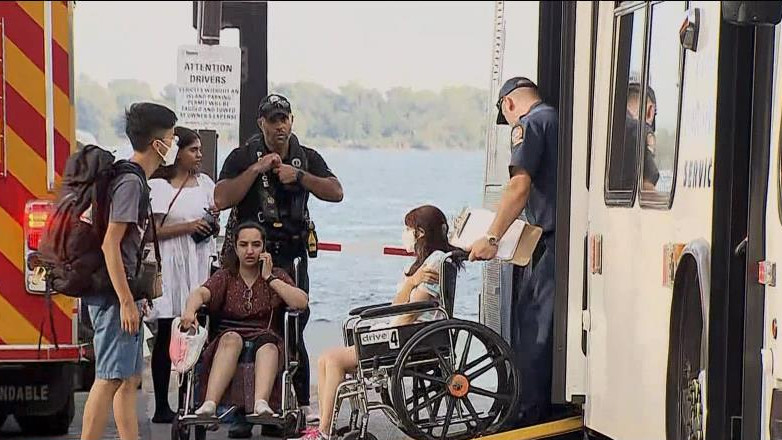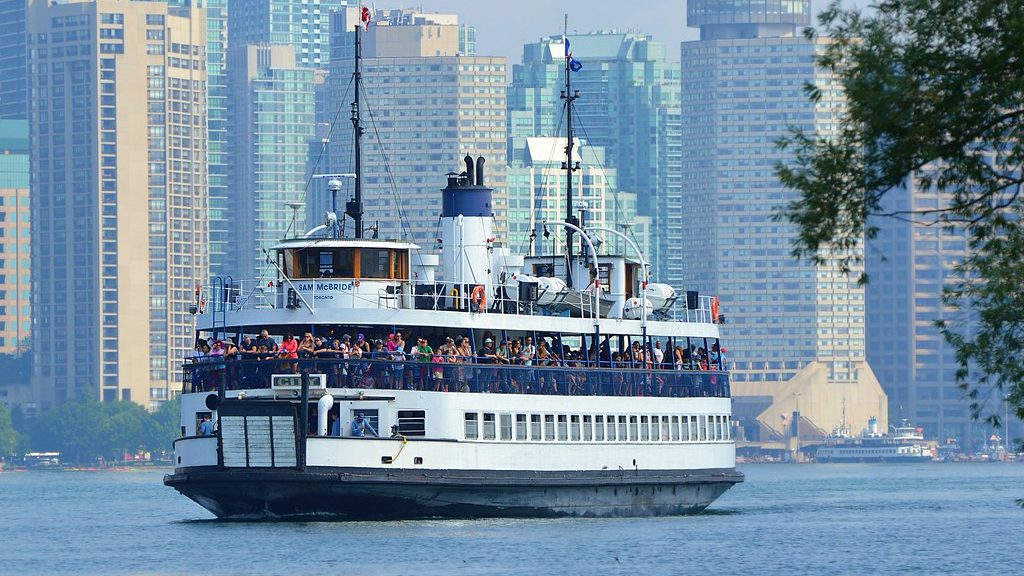Investigation into 2022 Toronto ferry crash found ‘safety deficiencies’

Posted August 19, 2024 11:22 am.
Last Updated August 19, 2024 1:46 pm.
The Transportation Safety Board of Canada (TSB) has concluded its investigation into the 2022 ferry crash at Jack Layton Ferry Terminal, revealing in a report published Monday that “safety deficiencies” contributed to the incident which injured several people, including children.
The TSB has also made several recommendations to prevent a similar occurrence in the future.
The crash occurred on August 20, 2022, when the Sam McBride passenger ferry left Centre Island and headed to the Jack Layton Ferry Terminal.
Six crew members and 910 passengers were on board.
Just after 5 p.m., the ferry violently struck the dock while berthing, causing around 20 people standing on or above the stairs to fall forward, suffering various injuries.
Most injuries were minor, but five people were taken to hospital. Among them was a three-year-old boy whose parents spoke to CityNews.
“I just saw his body fly. Our wagon and the wagon in front sandwiched him a bit,” Jasmine Mallory said after her son, Jack, was cut during the fall, requiring stitches.
“The injury to his eye we saw immediately. It was bleeding; there was blood all over his face,” she recalled.
Why was the ferry approaching the dock so fast?
The TSB’s investigation found that the ferry was behind schedule that day after already making eight crossings, most of them at full capacity. The TSB said “operational pressures” on employees likely contributed to the vessel’s speed.
“The TSB determined that at the time of the occurrence, the vessel approached the dock faster than it had on earlier trips that day and that only one of the vessel’s two propellers was turning as it approached the dock.”
“Given the vessel’s speed and distance from the dock, one propeller alone was not enough to stop the ferry. Both engines and their control systems were subsequently examined and found to be in good working order, without indication of a malfunction.”
The investigation also discovered that the City of Toronto didn’t have written procedures addressing issues like safe approach speed for docking.
“Instead, masters were left to operate in the way that they deemed appropriate. Without written procedures that defined safe practices for docking, decisions around travel or docking speed may have been influenced by operational pressures.”

FINDING 1: The crew on the Sam McBride were not trained in emergency passenger management because this training was not required. As such, had there been an emergency away from shore, the crew and those on board would not have been prepared to respond quickly and effectively.
RECCOMENDATION: Transport Canada implement a requirement for crew members of all passenger vessels, including those on sheltered waters voyages, to complete appropriate training in passenger safety management.
FINDING 2: The TSB also found that the ferry’s evacuation procedures were “unrealistic” with only six crew members left to manage over 900 passengers “while potentially completing multiple competing tasks at once throughout the vessel.”
RECOMMENDATION: Transport Canada implement a formal validation and approval process for passenger vessel evacuation procedures.
FINDING 3: On voyages of less than 12 hours, there is no requirement to keep a separate count of the children and infants on board. On the Sam McBride, counts were estimated and tracked using a hand-held tally counter; children, infants, and those who may require extra assistance were not counted separately. In the event of an emergency, it would be impossible to account for all passengers on board or ensure that there are an adequate number of appropriately sized life jackets available.
RECOMMENDATION: Transport Canada implement a process to validate that passenger vessels are keeping an accurate count of all passengers, including a separate count of the number of children and infants, on all voyages.
The TSB notes that since the incident, the city increased the staff size on the Sam McBride ferry to 13 and addressed some passenger safety issues, updating the pre-recorded safety briefings, adding additional signage, and warning passengers not to stand on the stairs while the vessel is moving.
The City of Toronto responded to the report and its recommendations on Monday, with a spokesperson saying it fully supports the findings.
“The report highlights important actions to increase safety in the operation of Toronto’s ferries. The City has been and continues to be in compliance with Transport Canada’s requirements and regulations and has already implemented a number of these actions, while continuing to implement others.”
“The City has documented its ferry safety protocols, invested in training staff, increased the number of life jackets onboard the vessels, improved lighting on the bridge deck and improved pre-departure safety briefings – all of which were implemented after the incident and continue to be our standards today.”








